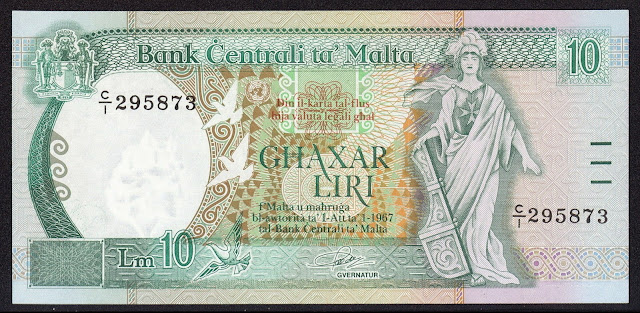Malta Banknotes 10 Maltese Lira banknote 1989
Central Bank of Malta - Bank Ċentrali ta’ Malta
Obverse: The central theme is a figure of a woman holding a rudder, symbolising Malta in control of her own destiny. Other features are three doves symbolising peace, the United Nations Emblem, the Central Bank of Malta Coat of Arms, and mosaic designs from the period of Roman presence in Malta.
Reverse: The Sette Giugno monument - 7 June 1919 Monument in Valletta, a wounded people brought into the National Assembly on 7th June 1919, the day when four Maltese citizens were killed (Aquarell of Gianni Vella [On June 7, 1919, Vella was at the Circolo La Giovine Malta in St Lucy Street, Valletta, where the Assemblea Nazionale was discussing a course of action in its dealings with the British colonial government]).
Watermark: Turreted allegory of Malta - Melita.
Format: 72.5mm x 145mm - Colour: Green.
Malta banknotes - Malta paper money
The 5th series of banknotes was issued in 1989 to coincide with the 25th anniversary of Malta’s independence. The banknotes depict the Edward Caruana Dingli allegorical figure of Melita holding a rudder. This represented Malta taking control of her own destiny.Maltese banknotes were replaced by euro when Malta became a member of the euro area and adopted the euro as its currency on 1 January 2008. Subsequently, the Maltese currency remained legal tender until 31 January 2008. However Maltese banknotes can still be exchanged for euro at the Central Bank of Malta for up to ten years after being demonetised, that is, till 31 January 2018.
2 Maltese Lira 5 Maltese Lira 10 Maltese Lira 20 Maltese Lira
Sette Giugno
Sette Giugno (from Italian for "Seventh of June") is a Maltese national holiday celebrated annually on 7 June. It commemorates events which occurred on that day in 1919 when, following a series of riots by the Maltese population, British troops fired into the crowd, killing four. This led to increased resistance and support for the pro-Italian parties that had challenged the British presence on the island.

